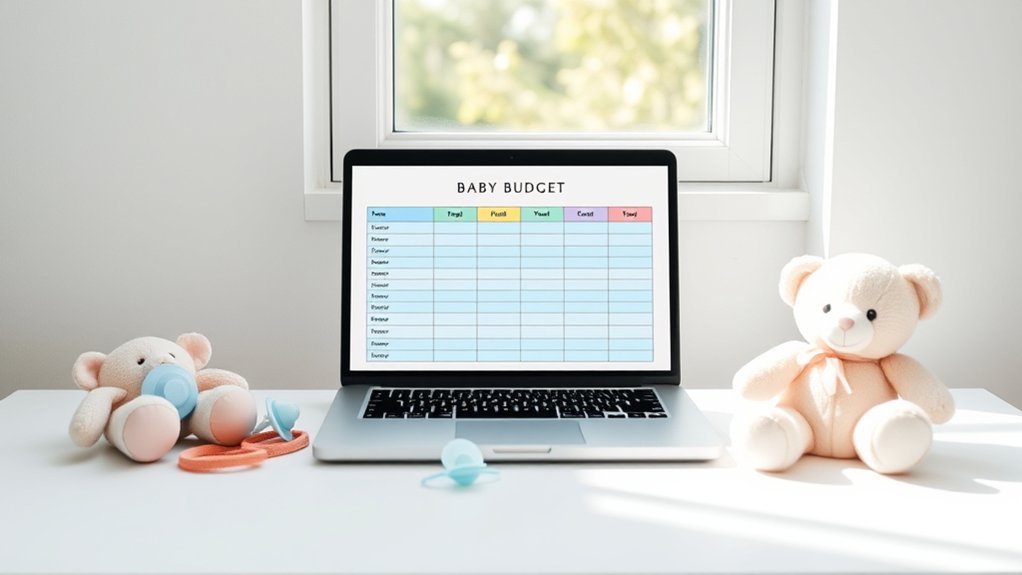Managing finances as a new parent can be challenging, and having a clear baby budget template is vital. You might wonder what expenses to include or how to tailor a budget that fits your family’s unique needs. Additionally, knowing how to adjust your budget as your baby grows can help you avoid financial stress. Let’s explore some common questions to guarantee you’re well-equipped for this journey.
What Is a Baby Budget Template?
A baby budget template serves as a structured framework to help new parents manage their finances during the exciting yet challenging time of welcoming a child. By outlining your income and expenses, you gain clarity on how to allocate resources effectively.
The template typically includes categories for essential costs like diapers, formula, and healthcare, as well as discretionary spending. Using this tool allows you to prioritize your financial obligations and anticipate future needs.
It also encourages you to track spending, ensuring you stay within your means. Ultimately, a baby budget template fosters financial awareness, helping you navigate this new chapter with confidence and security while reducing stress related to money management.
What Expenses Should I Include in My Baby Budget?
How can you guarantee you cover all necessary expenses in your baby budget? Start by identifying key categories that will help you manage your finances effectively.
Ensuring you cover all baby expenses starts with identifying key financial categories for effective budgeting.
Here are three essential expenses you shouldn’t overlook:
- Diapers and Wipes: These are ongoing costs you’ll face from birth through potty training. Factor in both disposable and cloth options.
- Healthcare: Regular pediatrician visits, vaccinations, and potential medical emergencies can add up quickly. Don’t forget about health insurance premiums.
- Baby Gear: Items such as cribs, strollers, and car seats are essential for your baby’s safety and comfort. Consider both one-time purchases and recurring costs for maintenance.
How Can I Create a Personalized Baby Budget Template?
Creating a personalized baby budget template starts with evaluating your unique financial situation and the specific needs of your family.
Begin by listing all potential expenses, including essentials like diapers, clothing, and healthcare. Next, assess your income sources and determine how much you can allocate monthly to these expenses.
Don’t forget to include one-time costs, such as baby gear and nursery setup. Organize your template into categories—fixed and variable expenses—ensuring you account for both immediate needs and future savings.
Adjust the template as needed, reflecting changes in your financial situation or family needs. Regularly reviewing and updating your budget will help you stay on track and manage your finances effectively as your baby grows.
What Tools Can I Use to Manage My Baby Budget?
Managing your baby budget effectively can be streamlined with the right tools at your disposal. Utilizing these tools not only helps you stay organized but also guarantees you’re making informed financial decisions.
Here are three essential tools you should consider:
- Budgeting Apps: Tools like Mint or YNAB (You Need A Budget) allow you to track your expenses in real-time and set savings goals specifically for baby-related costs.
- Spreadsheets: A simple Excel or Google Sheets template can be customized to categorize your expenses, making it easier to visualize where your money goes each month.
- Expense Tracking Software: Tools like Expensify can help you keep receipts and track spending, guaranteeing you never miss a detail in your budgeting process.
With these tools, managing your baby budget becomes much simpler.
How Can I Adjust My Budget as My Baby Grows?
As your baby grows and their needs evolve, it’s essential to reassess and adjust your budget accordingly. Start by identifying key areas where expenses might change, such as food, clothing, and childcare. Regularly monitoring these categories will help you stay on track. Here’s a simple table to guide your adjustments:
| Category | Current Budget | Adjusted Budget |
|---|---|---|
| Food | $200 | $300 |
| Clothing | $100 | $150 |
| Childcare | $500 | $600 |
As your child shifts from infant to toddler, these adjustments can have a significant impact. Keep an eye on trends in your spending and be proactive about reallocating funds to prioritize your growing child’s needs.
Frequently Asked Questions
Can I Use a Baby Budget Template for Multiple Children?
Yes, you can use a baby budget template for multiple children. Just adjust the expenses based on each child’s needs, ensuring you’re accurately tracking costs for essentials, childcare, and other related expenses for each child.
What if My Income Fluctuates During the Budgeting Period?
If your income fluctuates, adjust your budget regularly. Track expenses closely, prioritize essentials, and maintain a buffer for unpredictability. Flexibility is key; adapt your spending to guarantee financial stability during uncertain times.
Are There Any Free Baby Budget Templates Available Online?
Yes, you’ll find a treasure trove of free baby budget templates online. Websites like Canva and Excel offer user-friendly options, helping you navigate the financial waters of parenthood while keeping your expenses in check.
How Often Should I Review My Baby Budget?
You should review your baby budget monthly. This frequency helps you track expenses, adjust for unexpected costs, and guarantee you’re staying on target with your financial goals. Regular check-ins can enhance your budgeting effectiveness considerably.
Can I Incorporate Savings Goals Into My Baby Budget?
Yes, you can absolutely incorporate savings goals into your baby budget. By allocating specific amounts for savings each month, you’ll guarantee you’re prepared for future expenses while managing current needs effectively. Prioritize and adjust as necessary.
Conclusion
Creating a baby budget is essential for maneuvering the financial challenges of parenthood. Did you know that the average cost of raising a child from birth to age 18 is over $230,000? This staggering figure highlights the importance of planning and prioritizing your expenses. By using a personalized budget template and adapting it as your child grows, you can manage these costs effectively, ensuring you provide a nurturing environment without sacrificing your financial stability.
